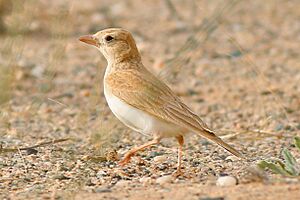Dunn's lark facts for kids
Quick facts for kids Dunn's lark |
|
|---|---|
 |
|
| Conservation status | |
| Scientific classification | |
| Genus: |
Eremalauda
|
| Species: |
dunni
|
| Synonyms | |
|
|
The Dunn's lark (scientific name: Eremalauda dunni) is a small passerine bird from the lark family. It is a desert bird that lives across parts of the Sahara Desert. You can find it from Mauritania in the west all the way to central Sudan in the east.
Contents
About Dunn's Lark Names
Scientists give animals special names to help group them. The Dunn's lark was first described in 1904. It was once thought to belong to different bird groups.
Today, the Dunn's lark is the only species in its group, called Eremalauda. This means it's quite unique! Another bird, the Arabian lark, was once thought to be the same species. But now, scientists agree it is a separate kind of lark.
What Does a Dunn's Lark Look Like?
The Dunn's lark is a sturdy bird. It has a big head and wide wings. It is about 14 to 15 centimeters (about 5.5 to 6 inches) long. Its wings can spread out to 25 to 30 centimeters (about 10 to 12 inches).
Its back feathers are a pale sandy-brown color. They have darker streaks, like stripes. Its belly is whitish. There are some dark streaks on its chest. You might also see a light stripe above its eye. It has a pale ring around its eye too. There are dark marks on its face, below its eye and near its beak.
The tail is short and wide. It is black underneath. The top of the tail is black with rusty-brown feathers in the middle. The outer feathers are pale. The bird's bill is large and strong. It is usually a pale pink or yellowish color. After the birds shed their old feathers, their colors become a bit duller. The dark markings also fade as the feathers get older.
Dunn's Lark Song
The male Dunn's lark has a special song. It sounds like a scratchy warbling. It also has short whistling sounds. Males sing from the ground. They also sing while flying high in the sky. They can hover 30 meters (about 100 feet) or more above the ground.
Where Dunn's Larks Live
In Africa, Dunn's larks live in different places. You can find them from Mauritania, through Mali, Niger, and Chad, to Sudan.
They like flat, dry areas. These places usually have light plants, like grass and scattered bushes.
How Dunn's Larks Live
Breeding and Nests
Dunn's larks make their nests on the ground. They dig a small hollow space. Then, they line it with plants. The female bird lays two or three eggs. The eggs are white. They have blackish and lavender spots. The parents sit on the eggs for 13 to 16 days. This helps the chicks grow inside.
What Dunn's Larks Eat
Dunn's larks mainly eat seeds and insects. They find their food on the ground. Sometimes, they use their strong bills to dig for food. When it's not breeding season, they often feed in groups. They move around a lot. This helps them find food after it rains in the desert.



